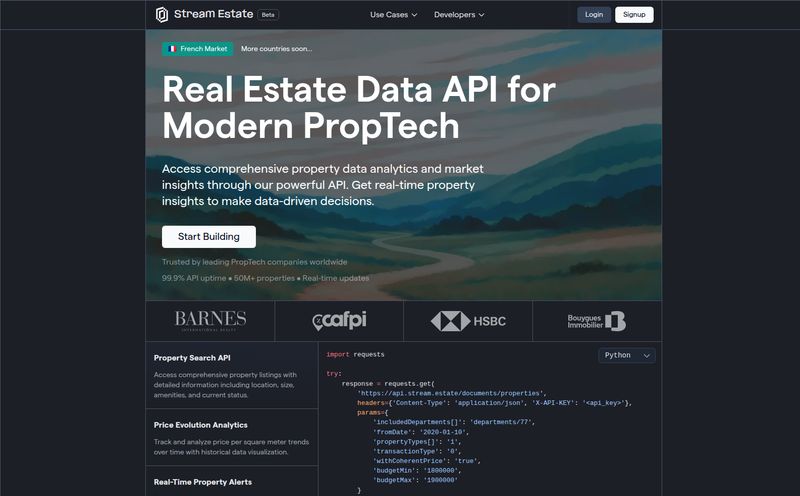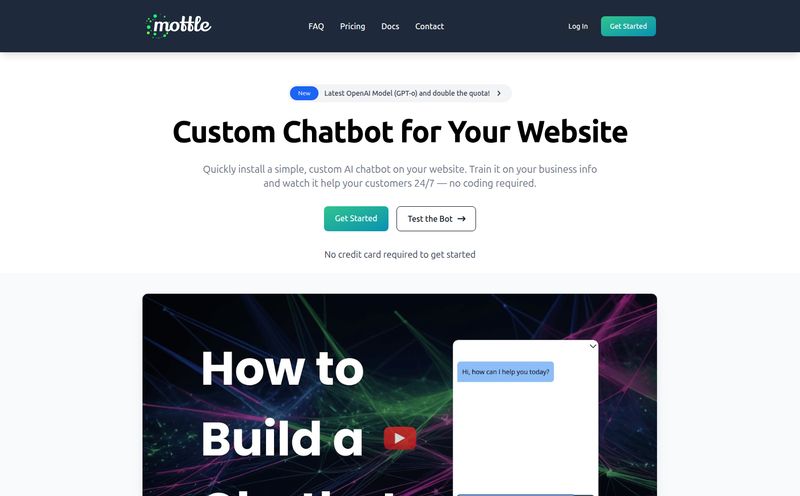Remember that one project? The one where you spent three hours just trying to get a stupid modal to vertically align perfectly on every screen size? Or maybe it was that dashboard layout that looked great in Figma but turned into a spaghetti monster of nested divs in practice. We've all been there. It’s the grunt work of frontend development that can sometimes suck the soul right out of you.
For years, we've heard whispers of AI coming to change the game. Most of it has been... well, a bit clunky. Fun for a demo, but not something you'd bet a client project on. Then Vercel, the folks who gave us Next.js, dropped v0.dev. And I have to admit, my curiosity was definitely piqued.
It bills itself as a “generative user interface system.” In plain English? You type what you want, and it spits out React code. But the real magic, and why my ears perked up, is that it’s built on the shoulders of giants: Tailwind CSS and the super-popular shadcn/ui. This isn't some black-box proprietary code; it's the stuff we're already using and love. So, is it any good? Let's get into it.
What Exactly is v0.dev? (And Why Should You Care?)
Think of v0.dev as a highly specialized AI assistant. It’s not trying to write your app's logic or manage its state. Its one and only job is to translate your description of a user interface into clean, copy-and-paste-ready React and JSX code. You say, “a pricing page with three tiers and a toggle for annual billing,” and it just… builds it. Or at least, a first draft.
The name itself—v0—is a brilliant piece of expectation setting. This isn't meant to be the final, polished v1.0 of your component. It's the starting block. It’s the cure for the blank page syndrome that plagues every developer. It’s like having a hyper-caffeinated junior dev who can instantly scaffold your ideas, letting you step in and handle the nuance, the logic, and teh final polish. And honestly, that’s a pretty compelling proposition.

Visit v0.dev
My First Impressions: Hitting the Ground Running
Getting started is simple. You head to the site, type a prompt, and watch the magic happen. It iterates, refines, and presents you with a visual preview alongside the code. My first prompt was something simple: “a user profile card with an avatar, name, username, and a follow button.”
What it generated in seconds was... pretty darn good. It was a solid 80% of the way there. The structure was sound, it used shadcn/ui components correctly, and the Tailwind classes were logical. Sure, I had to go in and tweak some spacing and maybe change a button variant, but it saved me a good 15-20 minutes of boilerplate typing. That's a win in my book.
You quickly learn that prompt clarity is everything. “A dashboard” is too vague. But “A sales dashboard with a top navigation bar, a sidebar for links, and four large stat cards at the top” gives it much better direction. It’s a skill in itself, learning to talk to the machine. But once you get the hang of it, the speed is intoxicating.
The Good, The Bad, and The Code-y
No tool is perfect, right? After playing with v0 for a few weeks, here's my honest take on where it soars and where it stumbles.
The Upsides: Where v0.dev Shines
The biggest advantage is raw speed. Prototyping an idea for a client or mocking up a new feature for your team goes from hours to minutes. This is huge. It completely changes the feedback loop. The ease of integration is another major plus. Since it’s just React components using established libraries, you can literally copy the code, paste it into your project (assuming you have Tailwind and shadcn/ui set up), and it just works. There's no weird vendor lock-in or proprietary framework to learn.
A Few Caveats to Keep in Mind
Okay, it's not all sunshine and rainbows. First, to copy the code, you need to sign in with a Vercel account. Not a dealbreaker for most of us in the React ecosystem, but it's a small hoop to jump through. Second, the code quality is directly proportional to your prompt's quality. A lazy prompt will give you lazy, sometimes slightly weird, code that needs more refactoring. Finally, and this is important, this tool doesn't replace you. It's an accelerator, not an autonomous developer. You still need your skills to integrate it, add functionality, and ensure it meets accessibility and design standards.
Let's Talk Money: The v0.dev Pricing Breakdown
This is where things get interesting. Vercel has opted for a usage-based model, which I personally appreciate. It feels modern and fair. There are a few main tiers, and then a credit system on top of that.
| Plan | Price | Best For |
|---|---|---|
| Free | $0/month | Individuals and hobbyists trying it out. Comes with monthly credits. |
| Premium | $20/month | Pro developers and power users needing more credits and faster generation. |
| Team | $30/user/month | Teams that need collaboration features and centralized billing. |
| Enterprise | Custom Pricing | Large organizations needing advanced security and dedicated support. |
Understanding the Credit System
This is the core of their "pay for what you use" model. Every time you generate or iterate on a design, it consumes credits. These credits are tied to "tokens," a concept familiar to anyone who's used AI APIs. More complex prompts and more powerful generation models (like the `v0-1.5-lg` model) consume more tokens, and therefore more credits. The free plan gives you a monthly allowance, which is more than enough to kick the tires and use it for small tasks. If you become a power user, you'll likely want the Premium plan for the bigger credit bundle.
Who is This Tool Actually For?
I’ve been thinking about this a lot. Who gets the most out of v0.dev?
- Solo Devs & Freelancers: This is a game-changer. It lets you build beautiful, functional frontends incredibly fast, which means you can take on more projects or deliver faster. The value proposition is off the charts.
- Startups & Small Teams: When you don't have a dedicated designer or a large frontend team, v0 can bridge the gap. It helps your developers build consistent, high-quality UIs without getting bogged down.
- Backend Developers: For backend folks who need to whip up a quick admin panel or a simple frontend for their API, this tool is a godsend. It handles the part they often find most tedious.
Who isn't it for? Probably absolute beginners who don't know React. You need a foundational understanding of how to take the generated code and wire it up to be useful. It's a tool for developers, not a replacement for them.
The Final Verdict: Is v0.dev Worth Your Time?
So, what’s my final take? Yes. Absolutely.
v0.dev has firmly earned a spot in my development toolbox. It doesn't write my whole application, and I wouldn't want it to. What it does is eliminate the most tedious part of my workflow: the initial, boring, time-consuming scaffolding of UI components. It’s a collaborator. A co-pilot. It lets me focus my brainpower on the more complex, creative problems—the logic, the user experience, the data flow.
It's one of the first AI coding tools I've used that feels genuinely useful and seamlessly integrated into a modern workflow. It’s not a gimmick. It saves time, and in our world, time is money. It's a fantastic look at the future of development, where human ingenuity is augmented, not replaced, by intelligent machines.
Frequently Asked Questions about v0.dev
- What's a 'token' in the v0.dev pricing?
- A token is the basic unit of measurement for your prompts and the code the AI generates. Think of it like words in an essay. Simple prompts use fewer tokens; complex ones use more. The pricing is based on how many millions of tokens you use.
- Do I really need a Vercel account?
- To browse and see examples, no. But to actually copy the code and use the more advanced features, yes, you'll need to log in with a free Vercel account. It’s how they manage your credits and usage.
- Can I get a refund if I don't use my credits?
- Based on their FAQ, purchased credits are generally non-refundable. The monthly credits that come with a plan expire at the end of the month, so be sure to use them!
- What happens if I write a bad prompt? Do I still pay?
- Yes. You pay for the generation process, regardless of the output's quality. This is why learning to write clear, specific prompts is key to getting the most value from the tool. It's a skill that pays off.
- Is the generated code ready for production?
- It can be, but you should always treat it as a starting point. You are still the developer in charge. You need to review it, test it, add your business logic, and make sure it fits perfectly within your application. It gives you a massive head start, but the final sign-off is on you.
Conclusion
The days of staring at a blank `index.js` file and dreading the CSS grind are numbered. Tools like v0.dev are fundamentally changing the developer's workflow for the better. It's not about making developers obsolete; it's about making them more efficient, more creative, and more focused on what truly matters. If you're a React developer, you owe it to yourself to give v0.dev a spin. It just might be the best new teammate you've had in years.



